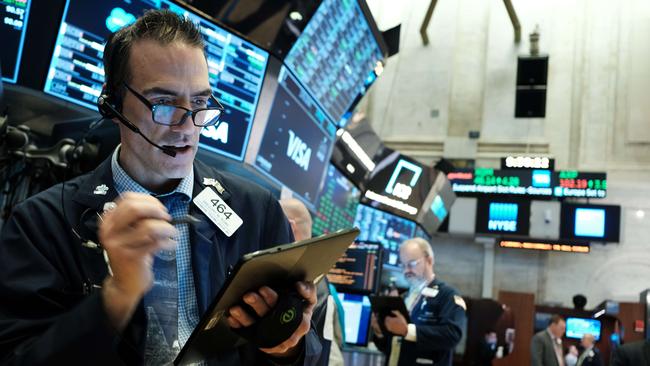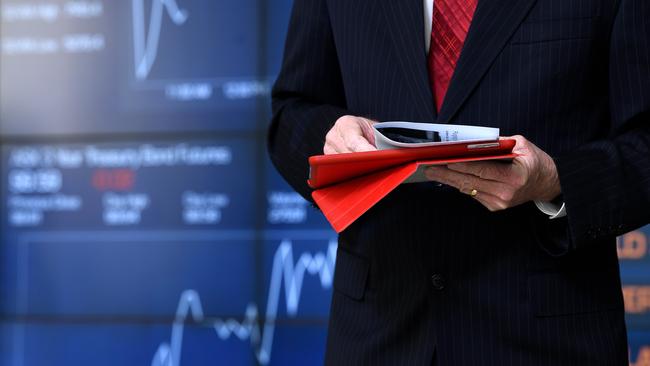Amazing rebound on market’s ‘most extraordinary day’
A multi-trillion-dollar injection of funds into global financial markets has sparked a stunning rebound in Australian shares.

A multi-trillion-dollar injection of funds into global financial markets by central banks around the world has sparked a stunning rebound in Australian shares and staved off the biggest collapse in global equities since the 1987 crash.
Central banks, including the Reserve Bank of Australia, responded with a massive liquidity surge to the coronavirus pandemic and related sell-off in shares that has started to spiral into a credit crunch.
After a crash of almost 10 per cent on Wall Street on Thursday, Australia’s S&P/ASX 200 share index plunged 431 points or 8.1 per cent to a four-year low of 4873.3 points before surging 13.7 per cent from the low to finish up 4.4 per cent at 5539.3 points — its best intraday bounce on record.
Before the fightback Australia’s market was on track for its worst daily performance since the 1987 crash.
“This was one of the most extraordinary days the market has seen,” said Bell Potter’s head of institutional sales and trading, Richard Coppleson. “You only ever see these types of days a handful of times in your life.”
More than $18bn worth of shares changed hands, a record value on the ASX. A typical day sees a little over $5bn traded.
The bounce came hours after the Fed signalled it would boost its cash injections to $US5.4 trillion ($8.6 trillion) over the next month, doing whatever it takes to stop short-term financing rates from spiking. The RBA followed on Friday by injecting nearly $7bn of liquidity into the financial system. The European Central Bank also announced a series of measures including a temporary expansion to its bond-buying program and loans for banks at interest rates as low as -0.75 per cent.

On Wall Street the Fed action sparked a dramatic turnaround, with the benchmark S&P 500 Index soaring 9.2 per cent on Friday night by the close of a volatile session. The Dow Jones Industrial Average rose 9.4 per cent and the tech-heavy Nasdaq lifted 9.3 per cent.
In the Fed’s third increase of its repo (repurchase agreements) schedule this week, the Fed’s New York branch offered $US500bn ($794bn) via three-month repos as the coronavirus pandemic triggered a rush for cash by companies. The Fed repeated that exercise on Friday along with a $US500bn one-month operation, and has promised to offer that amount on 10 occasions in total in the next month.
Still, markets are likely to stay volatile as global infection rates for the novel coronavirus continue to rise.
“Altogether, this is a massive injection of liquidity, in response to increased stress in US dollar funding markets,” said ANZ rates strategist Jack Chambers.
“There have also been signs of disruptions in Treasury markets, with sharp moves in the cheapest to deliver basis. This, along with the cross-asset selling seen in the Thursday session, is indicative of leveraged investors being unable to fund existing positions. While the Fed’s action is welcome and, combined with further monetary easing, may reassure markets of its willingness to act, it does not solve the underlying issue.”
The Bank of Japan offered to provide as much as 2.2 trillion yen ($33bn) of liquidity while South Korea slapped a 6-month ban on short selling and eased restrictions on share buybacks.
At its low point, the S&P/ASX 200 had fallen 32 per cent from a record high of 7162.5 points in just three weeks, having experienced its fastest shift from bull to bear market in history, and its 12-month forward price-to-earnings ratio hit a six-year low of 12.8 times versus a long-run average of 13.8.
“We saw the last of the capitulation selling that has been hitting all week and today it looked like we did see the bottom,” said Bell Potter’s Mr Coppleson.
“From here we just need the US to stabilise and we will be able to hold. “
The value of shares traded on the ASX — almost $20bn — was the biggest in history.
The Australian dollar followed a similar path, bouncing more than US1c to US63.26c after hitting an 11-year low of US62.13c after the crash on Wall Street.
S&P 500 futures fell 3.5 per cent in Asia before turning up 2.8 per cent.
Asian markets significantly pared their intraday falls but still closed in the red.
Japan’s Nikkei 225 fell 6.1 per cent, China’s Shanghai Composite fell 1.5 per cent, the Hang Seng index lost 2.5 per cent and South Korea’s KOSPI lost 3.9 per cent. Shares in Europe surged with London’s FTSE 100 Index up 3.2 per cent in morning trade and Germany’s Dax up 1.5 per cent.
Meanwhile, Australia’s 10-year bond yield surged as much as 31 basis points to 1.09 per cent — one of its biggest intraday swings on record — before closing up 21 basis points at 0.98 per cent.
“Sensible investors will be sitting on the sidelines and waiting for some more discernible stabilisation in the number of new (COVID-19) cases, and an appropriately big policy response,” Escala Partners chief investment partner Tracey McNaughton said.
“There’s a lot of uncertainty and we don’t have a reasonable grasp on when this will end. The key is keeping businesses operating and solvent.”
She said there were two clear risks for investors.
“The first is this shock will go on for longer, and so the stresses become greater. The second risk is the policy response is too little, and if that is the case then you might start to see job losses, which leads into mortgage distress and a consumption slowdown.”
Ms McNaughton said it was of “great concern that the US and Europe are two global superpowers and they seem to be fumbling their policy responses”.
It came as JPMorgan predicted a global recession caused by coronavirus.
The US investment bank has slashed its forecasts for the US and the Euro area to predict two consecutive negative quarters of economic growth in both of these major economies.
“If we have a recession here it’s very unlikely it will be a mild one,” said Gerard Minack of Minack Advisors said.
“We have zero per person income growth, with household debt-to-income at almost 200 per cent, and among the most expensive housing in the world.”







To join the conversation, please log in. Don't have an account? Register
Join the conversation, you are commenting as Logout